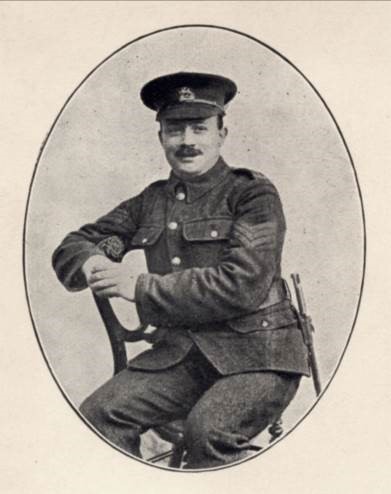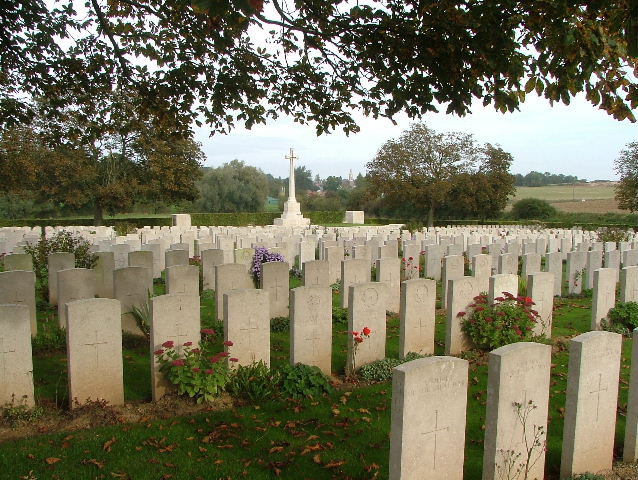Name
Fred Burton
Conflict
First World War
Date of Death / Age
02/12/1917
29
Rank, Service Number & Service Details
Serjeant
200950
Princess Charlotte of Wales’ (Royal Berkshire) Regiment
2nd/4th Bn.
Awards: Service Medals/Honour Awards
British War and Victory medals
Cemetery/Memorial: Name/Reference/Country
FIFTEEN RAVINE BRITISH CEMETERY, VILLERS-PLOUICH
VIII. D. 17.
France
Headstone Inscription
Not Researched
UK & Other Memorials
Pirton Village War Memorial,
St Mary’s Shrine, Pirton,
Methodist Chapel Plaque, Pirton,
Pirton School Memorial
Biography
The records of the Commonwealth War Graves Commission confirm Fred’s parents as David and Rose (Fanny(*1)) Burton (née Walker). They married some time around 1880 when he was an agricultural worker and publican, running The Red Lion in Crabtree Lane. This property is still there, near the entrance to the church and is now called Red Lion Cottage. They had four children(*2); Beatrice Ruth, Sydney Charles, Fred, born on January 29th 1888, and Thomas.
Pirton School records show that he was admitted in 1890 as Freddie Burton. By the 1901 census the family had moved to Great Green and David was working as a farmer and cowkeeper. Curiously Fred is absent and even with the power of the internet he was difficult to locate, as his birth place of Pirton was recorded as Parton. Eventually he was located in Trumpington Street, Cambridge where, at just thirteen, he was a domestic page to a Cambridge University professor of Sanskrit.
His family remained in Pirton. By 1911 Fred had moved on and was now a footman at Binfield Manor in Berkshire. He first worked for Mr Erskine and then later for his daughter upon her marriage to Mr Luard. The house was a large thirty-seven roomed property, originally built for William Pitt the Elder, so it is safe to assume that his employers were wealthy. The household consisted of 21, nine family members and 12 servants. A later newspaper reported that by the time Fred enlisted he had risen to the position of the family butler.
Both Fred and his brother, Sidney, enlisted – Sidney is detailed in the chapter on the survivors of the war. Fred enlisted some time around November 1914, joining the 2/4th Battalion of the local Regiment, the Princess Charlotte of Wales’s Royal Berkshire Regiment. This Regiment had only been formed in September and was established to accommodate the Territorials who had not signed up for overseas service and the many new recruits. They initially undertook UK service and were stationed at Gateshead from mid-January to late March 1916 and it was during this period that Fred’s father died.
In May, the Territorials who accepted overseas service and the other recruits moved to Luggershall on Salisbury Plain to wait for embarkation to France, where they arrived on May 27th 1916.
Their first action was in June, close to the Belgium border, and then they moved to the Somme in November, but were not involved to any great extent in that battle. During the early part of 1917 they were training in France. Fred was lucky to be given leave during February and was able to return to Pirton for a brief visit.
They remained in France and their next action was in April 1917. On the 1st, while they were in defending Vermand, 5 other ranks were killed, 15 wounded and 1 suffered shell shock. The next day they joined in the attack and the capture of the enemy line at Bihecourt-Ponne Copse, but 11 more men were wounded, 2 of whom later died.
In August they returned to Belgium and on the 23rd Fred and the Berkshires were in fighting in the mud at Passchendaele. Thirteen platoons of the 2/4th Royal Berks attacked a number of known strong points including Pond Farm, Hindu, Schuler, Somme, Hill 35 and Gallipoli (all trench names). After consolidating their position they fought off three counter attacks. During these two days, 7 officers were wounded and 2 killed or missing. In the other ranks 32 were killed, 111 wounded, 25 wounded or missing and 54 missing. On the 24th they rested.
The following three months were relatively quiet and spent first in Belgium, and then, from September 19th, in France. In October the Berkshires were in and out of the trenches, but it was still relatively quiet. On the 28th they marched to Arras for a period of training, returning to the line between November 11th and 30th, in the Chemical Works Sector, Arras. During this period 7 more men were killed and 14 wounded. Fred would have experienced most if not all of the action and by now he was probably battle-experienced and battle-hardened.
At 3:45am on December 1st 1917 the Battalion marched in the bitter cold, through mud and water, to Fins where they prepared for the next battle. On the 2nd, they were told that the Guards had retaken Gouzeaucourt and they were to join them to resist any counter attacks. They were in position by 5:30am and operational orders were given. About lunchtime Fred went to Battalion HQ with food for the officers and was killed on his way back to the mess cart. This was during the Battle of Cambrai; the Battalion’s participation was described as ‘marginal’, but that was not so for Serjeant Fred Burton.
Fred Burton was first recorded officially as missing and the North Hertfordshire Mail of December 20th reported the anxiety of his family at Great Green Farm and particularly that of his mother, who was a widow and had been ill for some time. They obviously hoped for the best, but received the unofficial news of his death on Wednesday December 19th. It came from his former employers, who had been notified by another soldier. Just three days later his mother died without receiving the official notification. She was only fifty-six and perhaps she was another, indirect victim of the war.
The remaining family produced this memorial card with its touching poem that appears here. They also ensured that his name was added to their parents' headstone in St. Mary’s churchyard.
Fred’s body was recovered and lies in the Fifteen Ravine British Cemetery to the east of Villers-Plouich - a village about eight miles south-west of Cambrai. It lies in beautiful rolling French countryside within sight of the village church. Originally it began as a very small cemetery, but was enlarged after the war to bring together scattered graves. It now contains 1,264 Commonwealth burials and commemorations of the Great War of which only 525 are identified, but there are special memorials to 44 casualties known or believed to be buried among them.
(*1) Recorded as Rose Mary at Sidney’s baptism, but Rose Fanny in the 1901 census and on the family headstone in St. Mary’s churchyard.
(*2) Beatrice Ruth (b 1881), Sydney Charles (b 1883), Fred (b 1888, January 29th) and Thomas (b 1886).
Additional Information
Text from the book: The Pride of Pirton
Acknowledgments
The Pride of Pirton book – www.pirton.org.uk/prideofpirton Chris Ryan / Tony French / Jonty Wild



